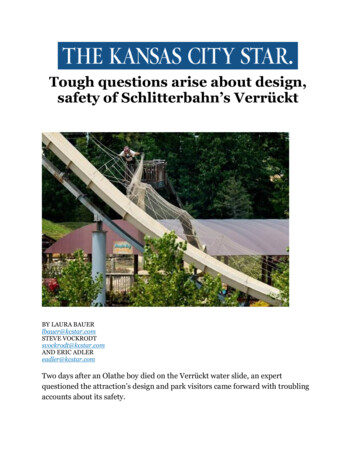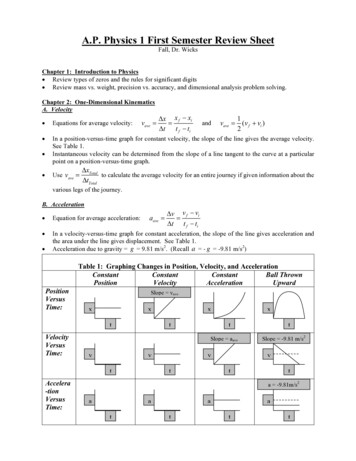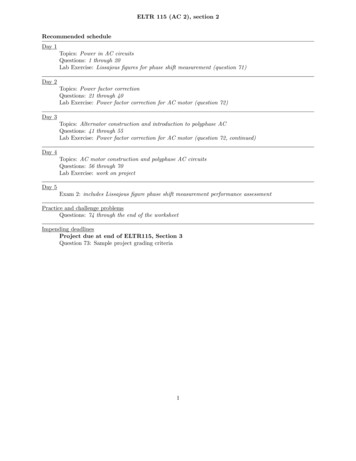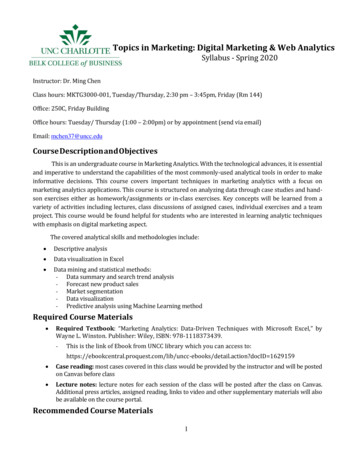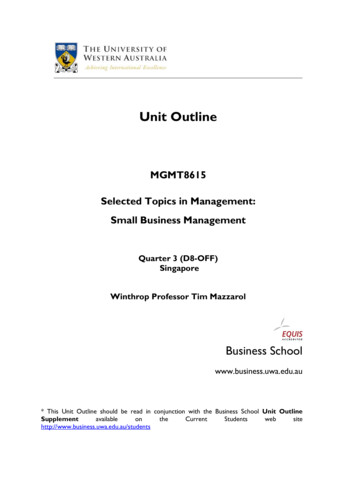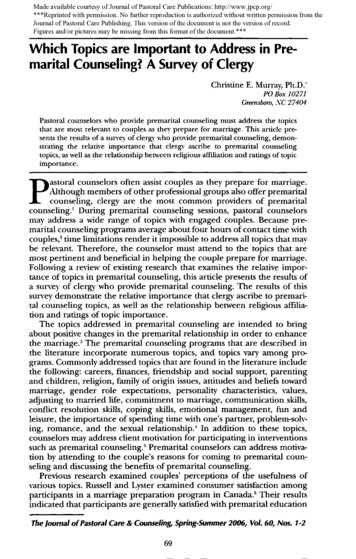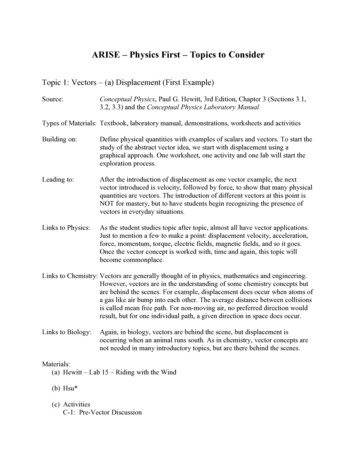
Transcription
ARISE – Physics First – Topics to ConsiderTopic 1: Vectors – (a) Displacement (First Example)Source:Conceptual Physics, Paul G. Hewitt, 3rd Edition, Chapter 3 (Sections 3.1,3.2, 3.3) and the Conceptual Physics Laboratory ManualTypes of Materials: Textbook, laboratory manual, demonstrations, worksheets and activitiesBuilding on:Define physical quantities with examples of scalars and vectors. To start thestudy of the abstract vector idea, we start with displacement using agraphical approach. One worksheet, one activity and one lab will start theexploration process.Leading to:After the introduction of displacement as one vector example, the nextvector introduced is velocity, followed by force, to show that many physicalquantities are vectors. The introduction of different vectors at this point isNOT for mastery, but to have students begin recognizing the presence ofvectors in everyday situations.Links to Physics:As the student studies topic after topic, almost all have vector applications.Just to mention a few to make a point: displacement velocity, acceleration,force, momentum, torque, electric fields, magnetic fields, and so it goes.Once the vector concept is worked with, time and again, this topic willbecome commonplace.Links to Chemistry: Vectors are generally thought of in physics, mathematics and engineering.However, vectors are in the understanding of some chemistry concepts butare behind the scenes. For example, displacement does occur when atoms ofa gas like air bump into each other. The average distance between collisionsis called mean free path. For non-moving air, no preferred direction wouldresult, but for one individual path, a given direction in space does occur.Links to Biology:Again, in biology, vectors are behind the scene, but displacement isoccurring when an animal runs south. As in chemistry, vector concepts arenot needed in many introductory topics, but are there behind the scenes.Materials:(a) Hewitt – Lab 15 – Riding with the Wind(b) Hsu*(c) ActivitiesC-1: Pre-Vector Discussion
C-2: Walking Vectors(d) Worksheet – Vector Practice Worksheet(e) 1. Demonstration – Step Vectors2. Vector Miscellaneous (a, b, c,)(f) Websites and Videos1. Mechanical Universe Video – “Vectors”(Captain Duke and crew lost at sea on good ship Irish tml2. Sailing Vector Lab Sim (Shockwave)(Animated interactive lab nload/download.cgi?P1ProdVersion ShockwaveFlash3. This entry is appropriate for all topics in this supplement guidebook. The videoscover all aspects of physics in demonstration form. They are called, “The VideoEncyclopedia of Physics Demonstrations” by The Education Group. They have onesample online that looks good and it is brief. The set of 25 DVD’s with 10 hours ofplay is 2,995.4. Science School House is interactive on the computer on most all physics topics(E&M, heat, mechanics, sound and waves, light in both video and software). Givesdetails and talogue/physics/videos(g) Good Stories – Direction
Topic 1: C-1 – Pre-Vector DiscussionThe purpose of this discussion with students is to begin an understanding of an abstract conceptsuch as a vector by using familiar examples. Daily situations use abstractions as well as math in aclassroom setting, so it is hoped that this discussion will begin the understanding.(a) First discussion: What does this symbol mean?(NO for whatever is at the center of the circle; e.g.,a swimmer in dangerous water, no passing on ahighway, etc.)(b) What does this symbol mean?(Stop Sign)(c) What does this symbol mean?(Double bracket to show all itemswithin are included)(d) What does this symbol mean?(Railroad Crossing)(e) What does this symbol mean?(Variable in an equation:X marks the spot.Put your name here, etc.)(f) What do these symbols mean?(His and her bathrooms)
(g) Can symbols be used to express an idea or concept?(Yes)(h) What does this arrow mean?(An arrow could represent going right, a push to the right, or in general, something to theright.)(i) What does this arrow mean?(The arrow shows somethingupward, e.g., motion, force ordirection.)(j) What is the difference between the arrow in (h) and this arrow?(Two things: First, this arrow goes left, not right; and secondly, this arrow is larger.)(k) What two properties of arrows seem to be illustrated by (h), (i) and (j)?(Size and direction)(l) Could an arrow indicate which way something moves?(Yes)(m) Could an arrow indicate how fast something moves?(Yes)(n) Could an arrow indicate the nature of force acting on an object?(Yes)(o) Summary: Can an arrow describe the size and direction of a physical quantity?(Yes)
Topic 1: C-2 – Walking Vectors (Displacement)Purpose:Experience one example of a vector by doing this activity.Materials Needed: Orienteering compass, deck of 5 displacement cards, starting objectPreliminary:Teacher input(a) How to use the orienteering compass(b) Discuss the 5 displacement cards: 10 steps south,10 steps east, 5 steps north, 5 steps west, 5 steps north(c) Show how to walk consistently by placing black electrical tape everymeter on the floor for 10 meters. (Students need to practice walking.)Procedure:(a) Students practice walking normal steps to become consistent. Try walking 10 steps in onedirection and turn around and walk 10 steps in the other direction. Where should you endup?(b) Go to a large open space (gym, outside, etc.) with your deck of cards and a starting objectlike a stake to mark your starting location.(c) Shuffle your cards.(d) Students begin at the chosen starting object and use their compass to walk the first card’sdisplacement. From that point, walk the second card’s displacement. Repeat for cards 3, 4and 5 and write the order in which you walked in the grid below.Card 1Card 2Card 3Card 4Card 5DistanceDisplacementTrial 1Trial 2Trial 3(e) What is the total distance walked in Trial 1?(f) What is the displacement in Trial 1?(g) Shuffle your cards and repeat steps d, e, and f for a second and third trial.Distance Trial 2 Displacement Trial 2 Distance Trial 3 Displacement Trial 3 Look at your distance walked and your displacement in each trial. What conclusion(s) can bedrawn about vector addition?
Topic 1: C-2 – Walking Vectors (Displacement) Answer Sheet (f on separate page)Trial 1Trial 2Trial 310 south5 west5 north10 east10 south10 east10 north10 north5 west5 west5 north10 south5 north10 east10 north353535Distance5 east5 east5 eastDisplacement(e) 35(f) 5 east(g) Distance Trial 2:Displacement Trial 2:Distance Trial 3:Displacement Trial 3:355 east355 east(h) Conclusion: The order of vector addition does not matter and results in the sameresultant, displacement.
Topic 1: (f) Walking Vectors (Displacement) Answer SheetOne possible addition to obtain resultant displacement:10 steps south, 10 steps east, 5 steps north, 5 steps north, 5 steps west
Topic 1: D – Vector Practice WorksheetPurpose:To become familiar with the concept of a vector. Displacement vectors areone example and will be used to introduce the topic.Theory:We will use the navigational coordinate system to define direction. Thismeans that north is drawn up on a map or sheet of paper, south is down, east isto the right and west is to the left.To describe how far, distance, in this exercise, one space on the evenly spacedgrid paper will be 10 units of distance. For a vector, the length of the linesegment indicates size and an arrowhead shows direction.1. Vector Examples:(a)10 units north(b)5 units south(c)15 units east(d)14.1 units northeast2. You draw these vectors:(a)10 units west(b)15 units south(c)28.2 units northwest(d)14.1 units southwestAdding VectorsTheory: After drawing your first vector, start the second vector where you stopped thefirst vector (the arrowhead). The vector sum starts at the tail of the first vectorand ends at the arrowhead of the second. This sum is called a resultant.
3. Examples: Vector Addition(a)Add 10 units southand 5 units southAnswers:Resultant 15 units south(b)Add 10 units northand 10 units east(c)Add 10 units westand 30 units eastR 14.1 units NE(d)Add 10 units westand 10 units southR 20 units eastR 14.1 units SW4. You add these vectors:(a)10 units north20 units south(b)20 units west20 units south(a)R (c)20 units east20 units east(d)20 units east40 units south(c)(d)(b)R Question:How can you obtain the resultant for 4d?R R
Topic 1: D – Vector Practice Worksheet Answer Sheet2a2b2c2d4a4b4c4dR 10 units southR 28.2 units southwestR 40 units eastR 44.7 units southeastQuestion:Measure the resultant to see how many spaces long it is: About 44.7 units southeast
Topic 1: E-1 – Step Displacement Vector DemonstrationA very visual, inexpensive, quick and effective way to illustrate vectors (displacement forstarters) is to begin by stepping off displacement vectors. Below is one possible presentation to aclass including guided questions to help students with the understanding of displacement vectors.The teacher could modify this create a student activity or use as presented. I have found thisdemonstration to work well and it is just about the correct length.1. Begin by lining up 10 or so objects (books, whatever) as location markers at 1 stepspacing in front of the class. Call an object near the center the 0 step marker.00000000000002. Define going to the right as positive and left as negative (a number line).3. Stand at 0 step and take 2 steps to the right (event 1).Ask: What distance did I travel? (2 steps)4. From this location, take 2 steps to the left (event 2).Ask: What distance did I travel? (2 steps)5. Ask: What is the same about events 1 and 2?(Both cover the same distance.)6. Ask: What is different about events 1 and 2?(The direction: Event 1 went right and event 2 went left.)7. Repeat from 0 step, but take 3 steps to the right (event 3).Ask: What distance did I travel? (3 steps)8. From this location, take 3 steps to the left (event 4).Ask: What distance did I travel? (3 steps)9. Ask: What is the same about events 3 and 4?(Both cover the same distance.)10. Ask: What is different about events 3 and 4?(Direction)11. Ask: What 2 physical properties about my stepping seem to describe what was done?(Distance and direction)12. Define a displacement vector: An arrow (directed line segment) that has size (distance inthis case, 2 and 3 steps) and direction (left and right in these cases).
13. Now start at location –1 step and go to location 2 steps (event 5).Ask: Will someone give me another event (6) that matches event 5? (Many possibleanswers, e.g., from –6 steps to –3 steps, from –2 steps to 1 step, from 2 steps to 5 stepsand so forth)14. Ask: What distance was covered in event 6? (3 steps) What displacement was covered inevent 6? ( 3 steps, to the right)15. Now, start at location 4 steps and go to location 1 step (event 7).Ask: Will someone give me another event (8) that matches event 7? (Many possibleanswers, e.g., from 0 step to –3 steps, from –1 step to –4 steps, from 6 steps to 3 steps andso forth)16. Ask: What distance was covered in event 7? (3 steps) What displacement was covered inevent 7? (-3 steps, to the left)17. Now, start at location 0 step and go 2 steps to the right. Next, take 2 steps at right anglesto the number line toward the students.Ask: What total distance did I travel? (2 2 4 steps)Ask: What displacement occurred? (Less than 4 but greater than 2) Using math, 2.8 stepsat 45 degrees to the number line. This is a 2-dimensional problem.
Vector Maze – Overview1. Find your way through the maze to reach planet Zog.2. The grid is on four squares per inch graph paper. Each square is one unit.3. Count the number of units up, down, right and left (north, south, east, west).4. Total all of the north-south units (vertical components). Up: 60, down: 81. Total: down 21(-21).5. Total all of the east-west units (horizontal components). Left: 24, right: 48. Total: 24.6. Graphically add the vertical and horizontal components.7. Draw the resultant.8. Find the magnitude and direction of the resultant.Discussion Points:1. Distance and displacement: How many units were actually traveled to get from the point oforigin to the point of destination?2. When at planet Zog, how far are you from where you started?3. Discuss the concept of components and resultants.4. Would any other path through the maze have given similar results?
cIIJ.pJt"tIfV- 1'(\,IV- ,/.'IV345360000 5180Y165, .-"-'
DirectionA sailor at sea out of sight of land sits at the center of a circle whose circumference is thehorizon. If he is standing on deck, eye level is about nine feet above sea level. At this height thediameter of his circle is only about seven miles. From the crow’s nest, about seventy-five feet,the diameter is now about twenty miles. It is this circle, which defines our sailor’s system ofnavigation.For the thirteenth century Italian sailor, the frame of reference is not a point on amagnetic compass but more physical phenomenon; for north, the prevailing winds; for south, themidday sun; for east, the sunrise; for west, the sunset. Northern Europeans were the first to usethe terms north, south, east and west to denote these directional properties. The Anglo-Saxonking Alfred the Great in the ninth century coined he terms northeast, northwest, southeast,southwest in order to add precision to the existing circular scale.The Chinese, centuries before any western writings, were aware of the directionalproperties of a metal needle when touched by a lodestone. It is interesting to note that theChinese refer to a south-pointing needle. Although apparently originating in early China, themagnetic compass, as a directional instrument, remained undeveloped by as late as the thirteenthcentury, at which time western technology surpassed its eastern counterpart.It would take the
ARISE – Physics First – Topics to Consider Topic 1: Vectors – (a) Displacement (First Example) Source: Conceptual Physics, Paul G. Hewitt, 3rd Edition, Chapter 3 (Sections 3.1, 3.2, 3.3) and the Conceptual Physics Laboratory Manual Types of Materials: Textbook, laboratory manual,


